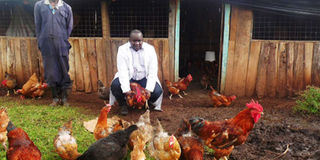DIARY OF A POULTRY FARMER: First step in cleaning infected chicken pen

Joel Maritim at Kabianga School dairy unit and at the chicken coop in Kericho.PHOTO |FILE
What you need to know:
From my research, some disease-causing organisms like mycoplasma and infectious coryza that have given me trouble (Seeds of Gold, August 27, 2016) can survive in the environment for hours to days, while others like coccidiosis are more fastidious and can linger on for months.
Another shocking thing is that even healthy looking birds once infected continue to shed germs that can hide in the environment – walls, ceilings, floors and clothing for long. As a result, I have learnt that depleting the entire stock and decontaminating the premises before bringing in new stock is a sure way to break the infection cycle.
Some weeks ago, I recounted the price every farmer must be ready to pay as I embarked on dry cleaning, washing and disinfecting my chicken houses to beat two diseases.
This process of decontamination is a key component of routine bio-security in poultry farming (Seeds of Gold, November 26, 2016).
Decontamination kills any disease organisms like bacteria, viruses, parasites and mold that might be present on the farm at the end of the production cycle or following a disease outbreak.
From my research, some disease-causing organisms like mycoplasma and infectious coryza that have given me trouble (Seeds of Gold, August 27, 2016) can survive in the environment for hours to days, while others like coccidiosis are more fastidious and can linger on for months.
Another shocking thing is that even healthy looking birds once infected continue to shed germs that can hide in the environment – walls, ceilings, floors and clothing for long. As a result, I have learnt that depleting the entire stock and decontaminating the premises before bringing in new stock is a sure way to break the infection cycle.
Now, before engaging Meshach the mason, I asked Cleophas to undertake thorough cleaning of the premises.
He first removed all equipment including drinkers, feeders and laying boxes. After cleaning, he then dried them in the sun and hanged in the store.
To disinfect the feeders and drinkers, he mixed a tablespoon of chlorine bleach in a gallon of boiling water and soaked them.
The next thing was to remove all the nets and polythene sheets from the walls and set them on fire. He then swept the floors and walls to remove all the dust. He also scraped manure and accumulated dust and dirt from the floor, perches and roosts. After removing all litter from the floor, he swept the floor again to remove as much dry material as possible. I personally inspected every step of the way and when I was sure the premises were sparkling clean, he started the wet cleaning.
For wet cleaning, I used common detergent washing powders used for laundering mixed with water. Now, a high pressure sprayer is good for this step, but in my case, I used a stiff hand brush to scrub manually. To rinse the floor, I was told hot water does a better job getting through organic matter than cold water, and that is what I used.
At this point, I thought I was done until I came across an article by Yoni Segal, a Food and Agriculture Organisation consultant on the matter.
“A good cleaning job will only remove 80 per cent of the germs and disinfection, using the right agent might kill remaining germs.”
If you recall, part of the problem the good vets that kept visiting my farm noted was the type of material I used to make the floor —wood.
You see, I used wood for the floor because my farm is situated in a swampy area. One day, it had rained and the chicken house was flooded (Seeds of Gold, December 31, 2016). Later, I decided to raise the floor about half a metre above the ground using posts and covered the floor using wood instead of cement.
Now, the good vets had rightly cautioned me against using wood. “Wood is not easy to clean and disinfect,” they said. For sure, physical materials such as dust, soil, wood and organic materials such as droppings, blood and secretions are notorious for protecting disease agents.
Meshach, the mason, came up with the idea to cover the wooden floor with a sheet of polythene paper and added half an inch layer of concrete mixed with cement and sand.
At first, I was skeptical because I thought the structure would not withstand the additional weight. This work took two days to complete but for now, I have a floor that I can easily clean and disinfect.
I didn’t stop there. After curing the floor, I asked Cleophas to clean it again using soap and water. For the walls, I have removed the old iron sheets at the back and replaced with new ones.
After dry cleaning and washing, the next thing I plan is to disinfect the premises. As a rule of the thumb, only disinfect after the building and equipment have been thoroughly cleaned.
For now, I am consulting the experts and doing my own research to find the right disinfectant. Keep reading.





